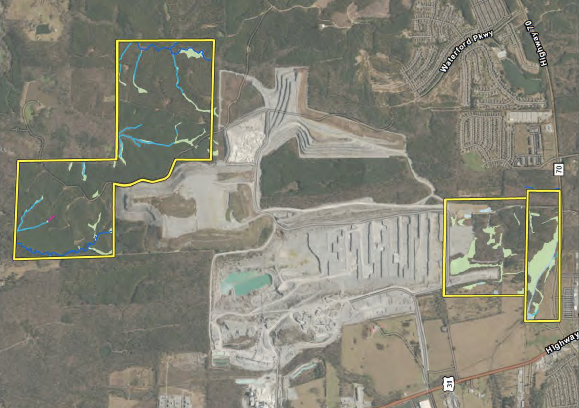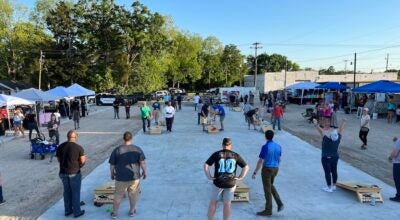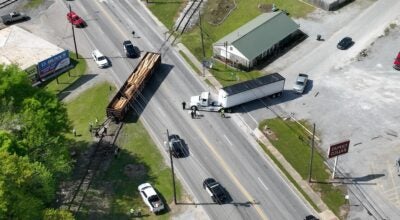Lhoist applies for permit to expand quarry, fill wetlands
Published 3:59 pm Tuesday, March 5, 2024

- On Feb. 14, the Army Corps of Engineers issued a joint public notice related to an application to discharge fill materials in wetlands and other waters in Calera. That public notice serves as the first step in an evaluation process that will decide if the application and subsequent project will move forward. (Contributed)
|
Getting your Trinity Audio player ready...
|
By DONALD MOTTERN | Staff Writer
CALERA – On Feb. 14, the Army Corps of Engineers issued a joint public notice related to an application to discharge fill materials in wetlands and other waters in Calera. The public notice serves as the first step in an evaluation process that will decide if the application and subsequent project will move forward.
As described in the notice, Lhoist North America has applied for a Department of the Army permit to fill areas of natural wetlands and other waters in order to appropriately expand areas associated with the O’Neal Quarry located at 3703 U.S. Highway 31 N in Calera for the purposes of limestone mining.
“The applicant is requesting authorization to discharge fill material into 11.21 acres of palustrine scrub shrub wetlands, forested wetlands and ponds and 171.4 linear feet of intermittent streams,” read the joint public notice issued by the Army Corps of Engineers. “Additionally, the applicant proposes to fill 7.08 acres of potentially isolated wetlands and ponds, and 100 linear feet of an ephemeral stream. The Corps has not made a jurisdictional determination at this time.”
For matters of clarification, palustrine wetlands are vegetated non-river or non-channel systems that traditionally include the likes of swamps, bogs, springs etc., while an ephemeral stream is a stream which only has flowing water as the result of, and for a short duration after, rainfall. Such streams are also located above the water table year-round.
According to representatives of TRC Companies, Inc., which serves as the agent for Lhoist, alternate locations for the project were researched and analyzed with a focus on the location and abundance of desired ore and its practical extraction. Additionally, matters related to the adverse environmental and community effects and property ownership concerns were also examined and taken into account.
“The agent (TRC Companies, Inc.) stated that the applicant has minimized impacts to waters of the United States—to be no greater than the extent necessary to complete the project safely and efficiently,” read the joint public notice. “(The agent stated that) construction best management practices (BMPs) would be utilized to reduce impacts to downstream aquatic resources.”
Also clarified in the public notice was the fact that the Army Corps of Engineers has not verified the adequacy of the Lhoist’s avoidance and minimization efforts at the time of the public notice’s writing. Such verification is expected to be part of the evaluation process.
In accordance with provisions of the Clean Water Act, Lhoist has also proposed to purchase wetland and stream credits from an approved mitigation bank.
“The applicant will apply for certification from the state of Alabama in accordance with Section 401(a) (1) of the Clean Water Act,” read the public notice. “Upon completion of the required advertising and public comment review, a determination relative to water quality certification will be made by the Alabama Department of Environmental Management.”
That determination and subsequent evaluation of the probable impact of the project will be among the deciding factors on whether a permit to move forward with the fill discharge will take place.
“That decision will reflect the national concern for both protection and use of important resources,” read the notice. “The benefit which reasonably may be expected to accrue from the proposal must be balanced against its reasonably foreseeable detriments. All factors which may be relevant to the proposal will be considered.”
Also, up for review is to determine if any endangered species exist or reside in the affected area. As listed in the public notice, the following species have the potential to occur in the project area and will be examined, searched for and determined as part of the project’s evaluation process:
- Gray Bat
- Indiana Bat
- Northern Long-Eared Bat
- Tricolored Bat
- Finelined Pocketbook
- Ovate Clubshell
- Southern Clubshell
- Southern Pigtoe
- Upland Combshell
- Tennessee Yellow-Eyed Grass
- Alligator Snapping Turtle
- Monarch Butterfly.
The evaluation period for the project by the Army Corps of Engineers is forthcoming and will incorporate public concern, input from local agencies and state services and public comment into its evaluation.









